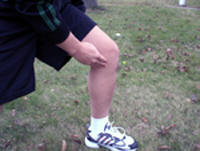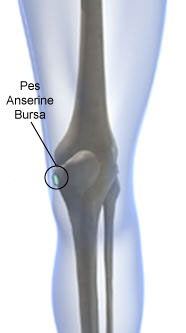|
Conditions & Treatments - Pes Anserine Bursitis |

Are you experiencing pain at your inner knee? Does this pain worsen with cutting, kicking, or squatting? If this is your situation, then you may be experiencing a condition called pes anserine bursitis. This is an injury that is commonly seen by a physical therapist and is often associated with trauma to the knee, overuse or poor mechanics. |
|
What is Pes Anserine Bursitis?  Pes anserine
bursitis is the inflammation of the pes anserine bursa located at the inner
aspect of the knee. The image provided displays the pes anserine bursa,
turquoise, of a left knee. The pes anserine bursa is a fluid filled sac
which acts as a cushion for the tendons of the sartorius, gracilis, and
semitendinosus muscles at the distal point of insertion on the shin bone
(tibia). The main function of these muscles are to help bend the knee, cross
the leg, turn the lower leg in, and give additional support to the knee
should a blow to the outside of the knee occur when the leg is planted.
Symptoms can include general pain, tenderness, and swelling at the inner
aspect of the knee if the pes anserine bursa is irritated. The pes anserine
bursa can be irritated if stress is placed on this area secondary to trauma
to the knee, overuse or poor mechanics. It is most often irritated with
activities or athletics which requires cutting, pivoting, kicking,
squatting, or quick side to side movements. In sports, it is a common injury
often found in swimmers who perform the breast stroke given the mechanics
required for this stroke. Pes anserine
bursitis is the inflammation of the pes anserine bursa located at the inner
aspect of the knee. The image provided displays the pes anserine bursa,
turquoise, of a left knee. The pes anserine bursa is a fluid filled sac
which acts as a cushion for the tendons of the sartorius, gracilis, and
semitendinosus muscles at the distal point of insertion on the shin bone
(tibia). The main function of these muscles are to help bend the knee, cross
the leg, turn the lower leg in, and give additional support to the knee
should a blow to the outside of the knee occur when the leg is planted.
Symptoms can include general pain, tenderness, and swelling at the inner
aspect of the knee if the pes anserine bursa is irritated. The pes anserine
bursa can be irritated if stress is placed on this area secondary to trauma
to the knee, overuse or poor mechanics. It is most often irritated with
activities or athletics which requires cutting, pivoting, kicking,
squatting, or quick side to side movements. In sports, it is a common injury
often found in swimmers who perform the breast stroke given the mechanics
required for this stroke. |
Pes Anserine Bursitis Treatment Options for a P.T.
· Have patient refrain from activities which increase symptoms
· Ice Massage/Ice Packs
· Postural Training/Functional Training
· ROM/Stretching (see videos 30, 31, & 24)
· Strengthening (see video 18, Z13)
· Massage/Soft Tissue Mobilization
· Joint Mobilization
· Gait Training
· Orthotics
· Ultrasound/Phonophoresis/Iontophoresis
| Comment - Message Board |
Last revised: June 6, 2008
by Chai Rasavong, MPT
|
|
|
|





